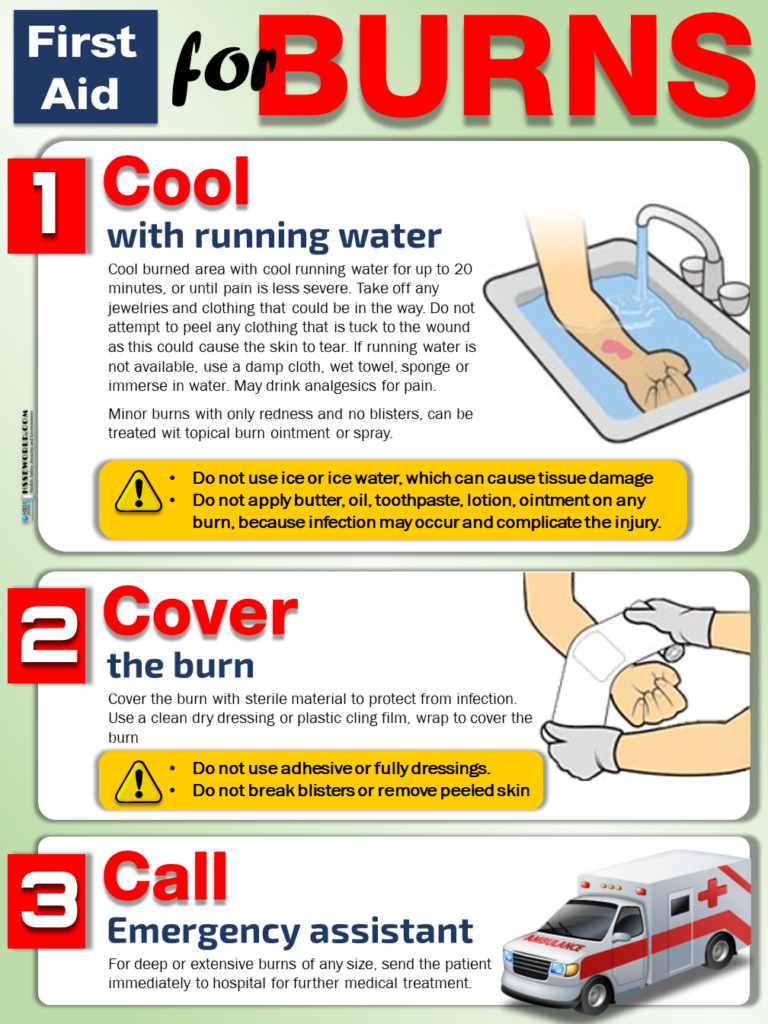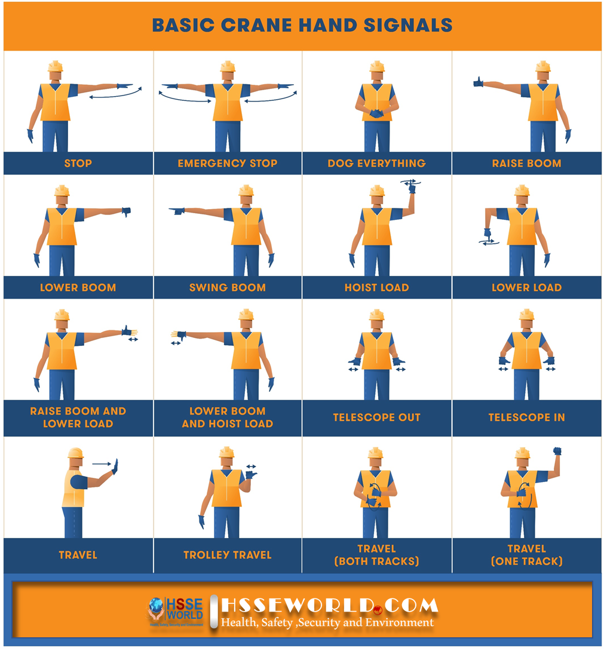Burns and scalds are damage to the skin usually caused by heat. Both are treated in the same way. A burn is caused by dry heat by an iron or fire, for example. A scald is caused by something wet, such as hot water or steam. Burns can be very painful and may cause:
- red or peeling skin
- blisters
- swelling
- white or charred skin
The amount of pain you feel is not always related to how serious the burn is. Even a very serious burn may be relatively painless. So our photo of today you will be familiar with :
- Type of burns
- Treating burns and First aid for burns
- When to go to hospital
- Electrical burns
- Acid and chemical burns
- Sunburn
Also, Read Photo of the day: Tips to reduce Heat stress in the workplace

Types of burn
Burns are assessed by how seriously your skin is damaged and which layers of skin are affected.
Your skin has 3 layers:
- the epidermis – the outer layer of skin
- the dermis – the layer of tissue just beneath, which contains blood capillaries, nerve endings, sweat glands, and hair follicles
- the subcutaneous fat, or subcutis – the deeper layer of fat and tissue
There are 4 main types of burn, which tend to have different appearances and different symptoms:
- superficial epidermal burn – where the epidermis is damaged; your skin will be red, slightly swollen, and painful, but not blistered
- superficial dermal burn – where the epidermis and part of the dermis are damaged; your skin will be pale pink and painful, and there may be small blisters
- deep dermal or partial thickness burn – where the epidermis and the dermis are damaged; this type of burn makes your skin turn red and blotchy; your skin may be dry or moist and become swollen and blistered, and it may be very painful or painless
- full-thickness burn – where all 3 layers of skin (the epidermis, dermis, and subcutis) are damaged; the skin is often burnt away and the tissue underneath may appear pale or blackened, while the remaining skin will be dry and white, brown or black with no blisters. The texture of the skin may also be leathery or waxy. It may also be painless
Also Read: Photo of the day: Safe Lifting at work
Treating burns and First aid for burns
Appropriate first aid must be used to treat any burns or scalds as soon as possible. This will limit the amount of damage to your skin. You can apply the following first aid techniques to yourself or another person who’s been burnt.
- Stop the burning process as soon as possible. This may mean removing the person from the area, dousing flames with water, or smothering flames with a blanket. Do not put yourself at risk of getting burnt as well.
- Remove any clothing or jewelry near the burnt area of skin, including babies’ nappies. But do not try to remove anything that’s stuck to the burnt skin, as this could cause more damage.
- Cool the burn with cool or lukewarm running water for 20 minutes as soon as possible after the injury. Never use ice, iced water, or any creams or greasy substances like butter.
- Keep yourself or the person warm. Use a blanket or layers of clothing, but avoid putting them on the injured area. Keeping warm will prevent hypothermia, where a person’s body temperature drops below 35C (95F). This is a risk if you’re cooling a large burnt area, particularly in young children and elderly people.
- Cover the burn with cling film. Lay the cling film over the burn, rather than wrapping it around a limb. A clean, clear plastic bag can be used for burns on your hand.
- Treat the pain from a burn with paracetamol or ibuprofen. Always check the manufacturer’s instructions when using over-the-counter medication. Children under 16 years of age should not be given aspirin.
- Raise the affected area, if possible. This will help to reduce swelling.
When to go to the hospital
Once you have taken these steps, you’ll need to decide whether further medical treatment is necessary.
Go to a hospital accident and emergency ( A & E ) department for:
- large burns bigger than the size of the affected person’s hand
- deep burns of any size that cause white or charred skin
- burns on the face, neck, hands, feet, joints, or genitals
- all chemical and electrical burns
- any other injuries that need treating
- any signs of shock symptoms include cold, clammy skin, sweating, rapid, shallow breathing, and weakness or dizziness
You should also go to the hospital if you or the person who has been burned:
- is under the age of 10
- has a medical condition, such as heart, lung, or liver disease, or diabetes
- has a weakened immune system (the body’s defense system) – for example, because of HIV or AIDS, or because they’re having chemotherapy for cancer
If someone has breathed in smoke or fumes, they should also get medical attention at the hospital. Some symptoms may be delayed, and can include:
- coughing
- a sore throat
- difficulty breathing
- singed nasal hair
- facial burns
You should also go to A&E if you have been injured intentionally, or think someone has been injured intentionally.
Electrical burns
Electrical burns may not look serious, but they can be very damaging. Someone who has an electrical burn should seek immediate medical attention at an A&E department.
If the person has been injured by a low-voltage source (up to 220 to 240 volts), such as a domestic electricity supply, safely switch off the power supply or remove the person from the electrical source using a material that doesn’t conduct electricity, such as a wooden stick or a wooden chair.
Do not approach a person who’s connected to a high-voltage source (1,000 volts or more).
Also Read: Types of electrical injuries
Acid and chemical burns
Acid and chemical burns can be very damaging and require immediate medical attention at an A&E department.
If possible, find out what chemical caused the burn and tell the healthcare professionals at A&E.
If you’re helping someone else, put on appropriate protective clothing, such as gloves, and then:
- remove any contaminated clothing on the person
- if the chemical is dry, brush it off their skin
- use running water to remove any traces of the chemical from the burnt area
Also Read: Tips for Chemical spills Preparation and Incident Response
Sunburn
Follow this advice for sunburn:
- If you notice any signs of sunburn, such as hot, red, and painful skin, move into the shade or preferably inside.
- Take a cool bath or shower for 10 minutes to cool down the burnt area of skin.
- Apply aftersun lotion to the affected area to moisturize, cool, and soothe it. Don’t use greasy or oily products.
- If you have any pain, paracetamol or ibuprofen should help relieve it. Always read the manufacturer’s instructions and do not give aspirin to children under the age of 16.
- Stay hydrated by drinking plenty of water.
- Watch out for signs of heat exhaustion or heatstroke, where the temperature inside your body rises to 37 to 40C (98.6 to 104F) or above. Symptoms include dizziness, a rapid pulse, or vomiting.
If a person with heat exhaustion is taken to a cool place quickly, given water to drink, and has their clothing loosened, they should start to feel better within half an hour.
If they don’t, they could develop heatstroke. This is a medical emergency and you’ll need to call 999 for an ambulance.
Also Read: Sunglasses Safety and Eye Health
Download the Infographic
Now you can download the Infographic ” First Aid for burns” and post it at the workplace to communicate with everyone to be familiar with the treatment and first Aids shall be taken in case of any burns
Also Read: First aid requirements at construction site
Photo of the day: First Aid for burns
Download more resources at SAFETY BAG
More photos:
- What are the Best Practices for Managing Subcontractor Risk
- Photo of the day: 10 Essential Safety Tips for Driving in Hot Weather Conditions
- Photo of the day: best workplace safety tips
- Photo of the day: The Importance of Stop Work Authority in Maintaining Workplace Safety
- Photo of the day: Tomorrow’s Reward for Working Safely Today: Cultivating a Culture of Safety
- Photo of the day: Preventing slips and trips at work
- Photo of the day: Learn the DRSABCD action Plan
- Working with Electricity Electrical Accidents Guide for Electrical Workers
- Photo of the day: Hearing Protection Device Selection
- Photo of the day: If An Earthquake Shakes You-Infographic free
- Fire Safety Posters Free Download
- Photo of the day: First Aid for Electrical Burns-Infographic free
- Infographic: First Aid for Cuts and Scrapes free download
- Photo of The day: Work Safe with Lasers-Laser Safety free
- Photo of the day: Working Safely with chemicals and chemical Management
- Photo of the day: Safe work practices when using MEWPs ( updated)
- Photo of the day: Preventing Common Kitchen Hazards
- Photo of the day: Safe handling of Gas Cylinders and lecture bottles
- Photo of the day: Forklift Stability Triangle
- Photo of the day: Defective Tools Safe Work Practice
- Photo of the day: Lift With Your Legs Not With Your Back
- Photo of the day: First Aid for burns
- Photo of the day: The 7 Principles of HACCP
- Photo of the day: Working Safely with Suspended Loads
- Photo of the day: Heat Stroke First Aid and safety posters
- Photo of the day: Near-Miss Reporting and Posters
- Photo of the day: Ergonomic chair and office chair safety tips
- Photo of the day: Whole Body Vibration
- Photo of the day: Substation Safety Equipment
- Photo of the day: Bypassing Safety Controls Rules
- Photo of the day: Lightning Safety Tips
- Photo of the day: Overhead Power lines Clearance
- Photo of the day: Floor Marking
- Photo of the day: Types of Foot Protection
- Photo of the day: Types of Hand Protection
- Photo of the day: Lockout and Tagout Safety
- Photo of the day: Fall Protection Plans
- Photo of the day: Flood Safety Tips
- Photo of the day: Read All Labels Work safe
- Photo of the day: Run Project safely with Crane Hand Signals
- Photo of the day: Flagman and Traffic control
- Photo of the day: Managing Risks of Exposure to Solvents in the workplace
- Photo of the day: Scissor Lift Safety
- Photo of the day: HSE Bulletin Board
- Photo of the day: Arc-Fault Circuit Interrupters (AFCI)
- Photo of the day: Safe use of ladders and step ladders
- Photo of the day: Concrete Truck Driver Hand Signals
- Photo of the day: Extension Cord Safety Tips
- Photo of the day: Protect your Head
- Photo of the day: choosing the right Anchorage
- Photo of the day: Work-Related Asthma
- Photo of the day: Top FIVE Heavy Equipment Construction Site Safety Tips
- Photo of the day: sun safety in the workplace
- Photo of the day: Cannabis and Impairment in the Workplace
- Photo of the day: Position for safety and comfort-Safety Tips
- Photo of the day: Generator Safety
- Photo of the day: Controlling COVID-19 in the Workplace-Physical Barriers
- Photo of the day: Manual Material handling
- Photo of the day: Personal Protective Equipment last resort
- Photo of the day: WHMIS 2015 – Pictograms
- Photo of the day: Indoor Air Quality
- Photo of the day: Noise in the affected workplace
- Photo of the day: Fatigue at Work
- Photo of the day: Don’t be Driven to Distraction
- Photo of the day: working in heat and Humidex Rating
- How to use Plate Clamps Safely: Safety Moment#34
- Photo of the day: Sitting at work
- Photo of the day: 5 ways to reduce the risk of Slipping and Tripping
- Photo of the day: Preventing the spread of contagious illness
- Photo of the day: Incident Investigations
- Photo of the day: 10 Scaffold Safety Essentials
- Photo of the day: Effective Health and Safety Committees
- Photo of the day: New worker Orientation & Safety Orientation checklist
- Photo of the day: Workplace Inspection
- Photo of the day: musculoskeletal disorders
- Photo of the day: Emergency preparedness in the workplace
- Photo of the day: Mental health in the workplace
- Photo of the day: Trenching Safety Tips That Can Save a Life
- Photo of the day: Dangerous Goods Classes
- Photo of the day: Safety Equipment for Confined Spaces
- Photo of the day: Tips to reduce Heat stress in the workplace
- Photo of the day: hierarchy of controls
- Your steps to chemical safety
- H2S Gas and how to handle its Emergency
- Photo of the day: Importance of Mock drill and Fire Action Emergency Procedure
- Photo of the day: Choosing the Right Face Mask and the difference between a respirator and face mask
- Photo of the day: Confined space safety Precautions
- Breath Safely: The Proper Use of Respiratory Protection
- Photo of the day: Electric shock survival
- Photo of the day: Chemical Spill Emergency Response
- Photo of the day: Construction Site fire Safety
- Photo of the day: Confined Space rescue
- Photo of the day: Conveyors Safety Tips





